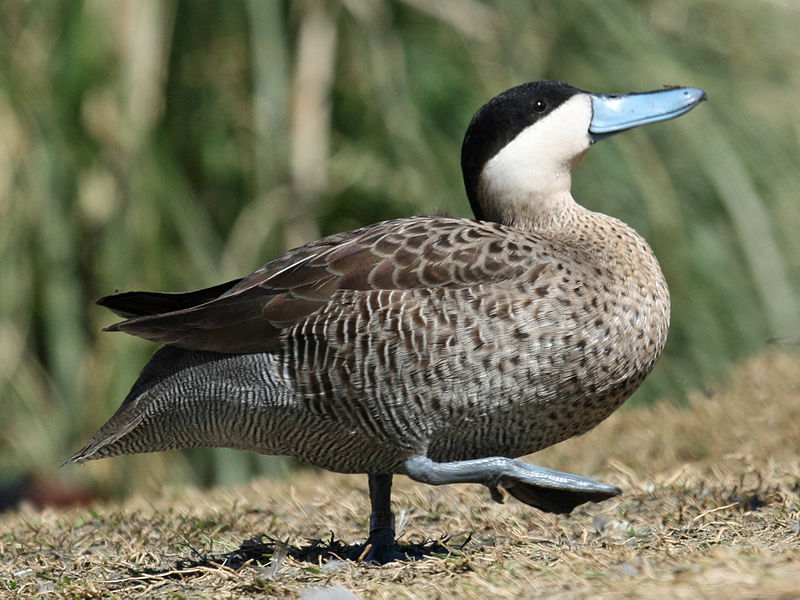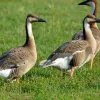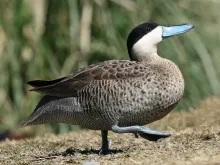
Puna teal (Anas puna)
Species name
- Dutch name:
- Puna taling
- English name:
- Puna teal
- German name:
- Punaente
- French name:
- Sarcelle de la puna
- Scientific name:
- Anas puna
Scientific classification
- Order:
- Anseriformes
- Family:
- Anatidae
- Onderfamilie:
- Anatinae
- Genus:
- Anas
Description
- Description:
Male:
Black cap, down to eye, and nape,and thin line down back of neck,sharply demarcateted from a almost white creamy cheek. The back, chest and lower flanks are light brown with dark brown spotting. The bill is a distinctive light blue with a black line down the middle. have brown eyes and dark grey legs and feet.Female:
As Male but smaller and Duller in color.Juvenile:
Well look like adults by the end of there first winter.
- Behaviour:
Puna teal (Anas puna) pair bond may be long-term. Puna teal do not usually mix with other species.
Usually pairs or small groups.
Standard Measurements
- Body Length (cm):
- The male (drake) of the Puna teal measures approximately 48-51 centimeters. The female measures approximately 48-51 centimeters.
- Body Weight (grams):
- The male will weight about 540-560 gram. The female will weight about 540-560 gram.
The weight is notoriously variable and can only be used as indication!
- Subspecies:
Previously considered subspecie:
- Silver teal - Anas versicolor
- Note:
Dabbling Ducks are generally hardy, easy to maintain and easy to breed. Shelter may be required by some of the smaller species in winter. They should be provided with cover (including marginal pond cover) and loafing areas as well as water. A pen which is 50% water is suggested. The water may be shallow (i.e. no more than two feet deep is required), and muddy areas for dabbling in are also appreciated. These ducks are generally good in mixed collections, although the smaller and quieter species may be bullied. Territorial disputes between ducks of the same species may be avoided by keeping only one pair of each species in an enclosure, unless the area is very large. For a single pair of ducks a pen are of 50 to 100 square metres, depending on the size of duck, should be provided.
A diet based on wheat and pellets is suggested, with maintenance pellets changed to breeders pellets for the breeding season. Bread and greenfood are also appreciated. Grit should always be available, with soluble grit (e.g. oystershell grit) as a calcium source when breeding.
Most species are ground nesters and both close ground cover and ground level nest boxes should be provided. Hand-rearing is generally preferred, as these ducks are generally poor parents in captive conditions, particularly in enclosures shared with other waterfowl. These ducks are prone to hybridization, particularly with closely related species, which should be kept apart from one another.
Puna teal are quite hardy, but quiet. These popular little ducks prefer natural cover and a secluded pen, particularly for breeding. Feed with wheat, pellets, greenfood, grass.
These ducks are easy to breed. Close ground cover, and ground-level or raised nest boxes should be provided. Eggs are normally laid April to May or June. Both parents participate in rearing.
Hybridisation reported with Silver teal (Anas versicolor); (previously considered subspecies).
Well established and regularly bred in waterfowl collections.
- Breeding:
- The female Puna teal usually lays from 5-7 pale creamy or pale pinkish eggs and incubates them for 25-27 days.
- Artificial incubating:
The ideal relative humidity for incubating most waterfowl eggs is 55% (ground nesters) and 40% (cavity nesters). The temperature is usually 37.4°C. Set ventilation as recommended by the incubator manufacturer. Eggs must be turned, either automatically or by hand, a minimum of 4 times a day. As the duckling develops there is a loss of water from the egg and the air sac gets bigger. In normal development of an egg with a 25-27 days incubation, the air sac occupies about a third of it three days earlier. Cleanliness is vital and ideally eggs should be moved to a separate hatcher at this point, where the humidity should be increased to 65% and even higher once they have pipped internally.
- Bird banding:
- Recommended closed leg band ring size for the Puna teal is 9 mm.The leg band ring can only be applied on a young dabbling duck at around 11-12 days old.
- It doesn't matter what leg that you band, but it's good to have a consistent system. Suggested: Left leg = Female, Right leg = Male
- Maintenance food:
-





Lundi Regular with a protein content of 20%, valuable Spirulina and high-quality by-products is optimally balanced in its composition maintenance food for water ornamental fowl of all kinds. Especially green teal and Whistling ducks that are not dependent on a very high protein content, are well supplied.
Lundi Regular contains all the minerals and vitamins in full form that are important for the animals. Therefore also suitable as breeding food.
